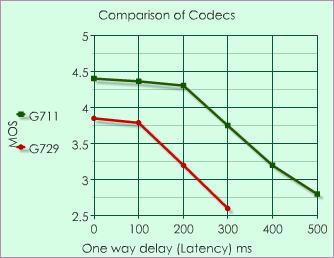Measuring MOS for VoIP test
MOS- Mean Opinion Score for VoIP
Testing
MOS or Mean Opinion Score gives VoIP testing a number value as an indication of the perceived quality of received voice after being transmitted and compressed using codecs. This measurement is the result of underlying network attributes that act upon data flow and is useful in predicting call quality and is a good VoIP test tool in determining issues that can affect your VoIP quality and your conversations.
Using MOS scores to evaluate your VoIP service.
 Testing the quality of VoIP has become easier and services have
greatly improved over the last few years due to both the providers
becoming more reliable and the ISPs offering better
connections. This advancement in the quality of services has
helped increase the number of VoIP subscribers, but occasionally
issues affecting voice quality do arise and being able to test your
VoIP and identify these instances can be helpful in addressing
them. Having a metric to measure changes or degradation in the
quality of the voice/VoIP connection after testing can help identify
problems. VoIP calls often are in the 3.5 to 4.2 MOS
range. The following chart can be used as a guide for VoIP MOS
testing and a good comparison for voice quality.
Testing the quality of VoIP has become easier and services have
greatly improved over the last few years due to both the providers
becoming more reliable and the ISPs offering better
connections. This advancement in the quality of services has
helped increase the number of VoIP subscribers, but occasionally
issues affecting voice quality do arise and being able to test your
VoIP and identify these instances can be helpful in addressing
them. Having a metric to measure changes or degradation in the
quality of the voice/VoIP connection after testing can help identify
problems. VoIP calls often are in the 3.5 to 4.2 MOS
range. The following chart can be used as a guide for VoIP MOS
testing and a good comparison for voice quality.
| Maximum for G.711 codec | 4.4 |
| Very satisfied | 4.3-5.0 |
| Satisfied | 4.0-4.3 |
| Some users satisfied | 3.6-4.0 |
| Many users dissatisfied | 3.1-3.6 |
| Nearly all users dissatisfied | 2.6-3.1 |
| Not recommended | 1.0-2.6 |
MOS comparison values
MOS- Test Your VoIP
You can test your VoIP connection and get your MOS score.
What affects your VoIP MOS test score.
First, it is important to understand that MOS - Mean Opinion Score - is a relative scale and is built upon many factors which can affect voice quality. VoIP measurements are collected for after testing the one-way delay or the latency of the connection, packet loss with a metric to include the number of consecutive packets lost, and the amount jitter (difference in time it takes packets to arrive). Calculations then factor an R Factor that can be used to estimate a MOS score.
Propagation delay which is is
the time required for a digital signal to travel end-to-end across
the entire network. The greater the distance the greater the
propagation delay. Additionally the data has to travel through
network routers, switches and other devices like firewalls, each
adding its own (transport) delay.
Packetization delay which is the
time required to digitize the signal for the codec used for sending
over the internet and decode it at the far end. A more compressed
codec like G.729 has a higher packetization delay than a
non-compressed codec like G.711 codec.
Jitter buffer is the delay
introduced by the ATA device to hold one or more datagrams, to
compensate in variations of arrival times. In VoIP a jitter buffer
is an area where voice packets can be collected, stored, and then
sent to the processor in more evenly spaced intervals. Variations in
packet arrival time (jitter) is usually the result of network
congestion or route changes. The jitter buffer, which is located at
the receiving end device of the voice connection, intentionally
delays the packets so that received voice is presented correctly
with less distortion.
The following items can all affect call quality:
- Bandwidth
- Codec in use.
- Hardware
- Jitter
- Latency
- Packet Loss
Codecs- how they affect MOS- Mean Opinion Score
A non-compressed codec, G711, will give the best voice quality, as no compression and decompression is required. This in turn makes this G711 less susceptible to packet loss, which even in small amounts will quickly degrade voice quality. Other codecs which use compression techniques consume less bandwidth, a good thing, but this compression process in itself lowers the voice clarity and introduces a delay. Additionally, compressed codecs are even more susceptible to packet loss. In addition G711 will maintain better quality with more latent connections, whereas compressed codecs' voice quality can quickly degrade as latency increase, as the chart below reflects.


